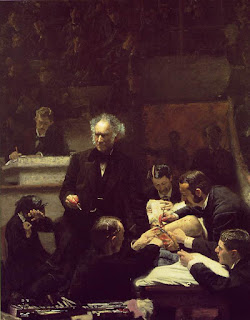Yesterday, I was honored to participate in the White Coat Ceremony, marking our induction into training as physicians. After class, I headed home and picked up my very dapper husband and baby and headed to "the Annex," a classroom north of campus where the event was being held. I learned a few interesting factoids I'd like to share with you.
In the late 1800s, it became the style for physicians to wear white; this also marked the end of the era when doctors wore dark colors (thank you, Dr. Selfridge for this tidbit.)
Both of these paintings are by the American painter, Thomas Eakins.
The first is entitled, The Gross Clinic. It was completed in 1875.
The second is The Agnew Clinic, completed in 1889.
In the span of fourteen short years, doctors changed the face (and clothing) of medicine. Today, we honor that tradition by donning our white coats. It was an emotional moment for me. It represents the responsibility of learning and training. There is a weight to the coat which the fabric doesn't supply. When I wear it, I am entrusted with my patient: his secrets, his emotions, his very body. I consider it an honor to study medicine. I pray that I will do so faithfully so that I can best serve those for whom I will care.
We ended the ceremony by repeating the Hippocratic Oath. Hipprocrates himself is not the author, but because of his early work in medicine, we honor him with the title. The modern version of this oath reads,
"I swear to fulfill, to the best of my ability and judgment, this covenant:
I will respect the hard-won scientific gains of those physicians in
whose steps I walk, and gladly share such knowledge as is mine with
those who are to follow.
I will apply, for the benefit of the sick, all measures [that] are
required, avoiding those twin traps of overtreatment and therapeutic
nihilism.
I will remember that there is art to medicine as well as science, and
that warmth, sympathy, and understanding may outweigh the surgeon's
knife or the chemist's drug.
I will not be ashamed to say 'I know not,' nor will I fail to call in
my colleagues when the skills of another are needed for a patient's
recovery.
I will respect the privacy of my patients, for their problems are not
disclosed to me that the world may know. Most especially must I tread
with care in matters of life and death. If it is given me to save a
life, all thanks. But it may also be within my power to take a life;
this awesome responsibility must be faced with great humbleness and
awareness of my own frailty. Above all, I must not play at God.
I will remember that I do not treat a fever chart, a cancerous growth,
but a sick human being, whose illness may affect the person's family and
economic stability. My responsibility includes these related problems,
if I am to care adequately for the sick.
I will prevent disease whenever I can, for prevention is preferable to cure.
I will remember that I remain a member of society, with special
obligations to all my fellow human beings, those sound of mind and body
as well as the infirm.
If I do not violate this oath, may I enjoy life and art, respected
while I live and remembered with affection thereafter. May I always act
so as to preserve the finest traditions of my calling and may I long
experience the joy of healing those who seek my help."
I'm not ashamed to say that I had tears in my eyes as my colleagues and I made this vow.
If you are interested in watching the ceremony, you can find the link below:
White Coat Ceremony RUSM January 2017
For His glory,
KCE





Oh my, the 'weight' of your white coat. How proud we are of you!! The oath is certainly a powerful charge. May God grant you the wisdom needed throughout your service! Love you all!
ReplyDelete